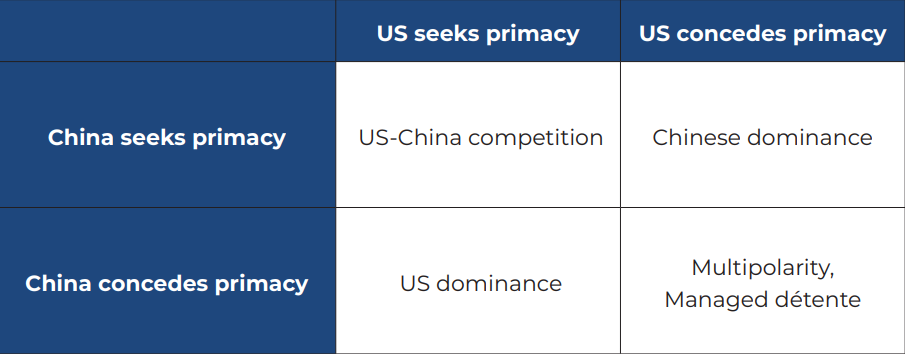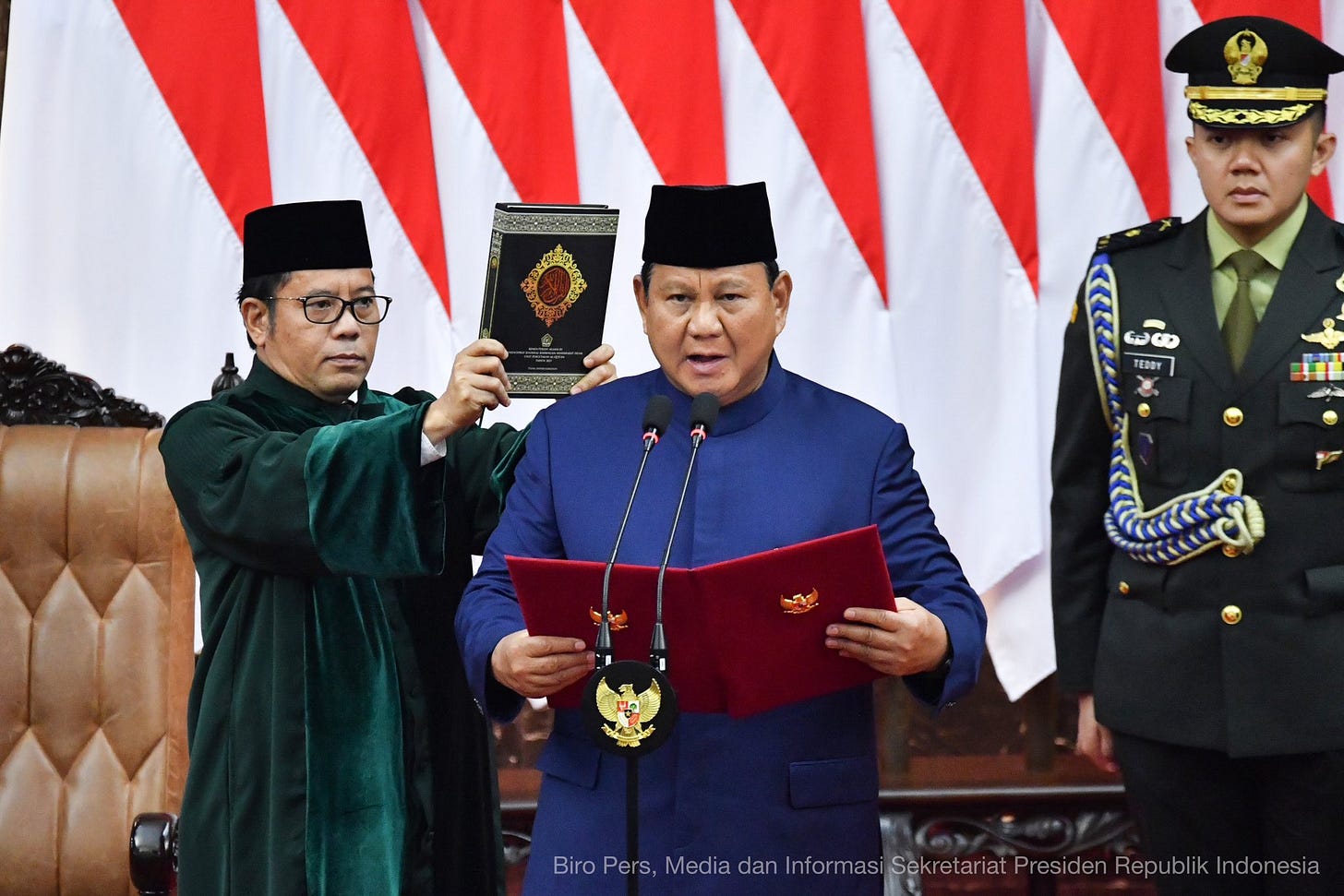Prabowo Inaugurated Amid Indonesia Foreign Policy Uncertainties
Plus new trilateral spotlight; world's first cyber pact; emerging 6G chatter; shifting submarine cables; maritime fallout management and much, much more.
Greetings to new readers and welcome all to the latest edition of the weekly ASEAN Wonk BulletBrief! If you haven’t already, you can upgrade to a paid subscription for $5 a month/$50 a year below to receive full posts by inserting your email address and then selecting an annual or monthly option. You can visit this page for more on pricing for institutions, groups as well as discounts. For current paid subscribers, please make sure you’re hitting the “view entire message” prompt if it comes up at the end of a post to see the full version.
For this iteration of ASEAN Wonk BulletBrief, we are looking at:
Assessing geopolitical and geoeconomic dynamics of foreign engagement under newly-inaugurated Indonesia president Prabowo Subianto;
Mapping of regional developments, such as new trilateral spotlight; maritime fallout management and coming strategic partnership;
Charting evolving geopolitical, geoeconomic and security trends including world’s first cyber pact; emerging 6G chatter and shifting submarine cables;
Tracking and analysis of industry developments and quantitative indicators such as trilateral corridor gains; first regional sectoral pact; payment connectivity inroads and more;
And much more! ICYMI, check out our new podcast episode with one of Vietnam’s leading diplomats on the country’s foreign policy futures.
This Week’s WonkCount: 2,127 words (~10 minutes)
New Trilateral Spotlight; Maritime Fallout Management; Coming Strategic Partnership & More

US-China Regional Futures; Supply Chain Realities & Power Pathways
“The report finds that there is no common preference for which end-state can best maintain regional stability,” notes a new report from the Asia Pacific Leaders Network which examines four regional end state preferences for stability (US-China competition; US dominance; Chinese dominance; and multipolarity/managed detente). The report finds that while there is some wariness of US and China primacy, views of “non-primacy end states” are diverse and different from those championed by China, including countries seeing themselves as poles and their actions diverging from their preferences (link).
Representation of Four Preferred End-States of Actors in the Asia-Pacific
“Notably, 88 percent of Southeast Asian trade flows stay within the Asia-Pacific region…trade flows between Southeast Asia and the world outside APAC amount to less than 10 percent of global trade,” notes a recent article by McKinsey addressing diversifying supply chains in Southeast Asia. The piece also notes other trends including inroads by Indonesia and Vietnam in manufacturing and China’s continued role as a key regional exporter (link).
Select Southeast Asia Export Flows by Destination (2023, million tons and %)
“In the case of the ASEAN Power Grid, developing a regional institution based on binding mandates is necessary for driving energy integration with confidence, despite possible difficulties posed by political challenges,” argues the latest iteration of the ASEAN Energy Outlook amid increasing interest in accelerating regional power trading in Southeast Asia. The full document, which runs nearly 200 pages, includes aggregate energy scenarios, recommendations as well as potential energy pathways looking at areas like supply, access, and regional power schemes including power trading (link).
Depiction of ASEAN Power Grid, Including Existing and Planned Interconnections in Southeast Asia
Prabowo Era Kicks Off in Indonesia Amid Foreign Policy Questions
What’s Behind It
Early foreign policy engagement of the Prabowo government was a key storyline amid his presidential inauguration on October 20. As we have been noting on ASEAN Wonk following our visits to Indonesia, since Prabowo’s victory in Indonesia’s February elections, everything from the country’s approach to key groupings to his long list of foreign trips have been scrutinized for a sense of continuity and change in defense and foreign policy. Prabowo’s inauguration was not immune from this in the first transition in a decade for the world’s fourth most populous country. Of particular note was spotlight on aspects such as country delegation compositions. China’s delegation was headed by its vice-president, while Australia and U.S. delegations were headed by a deputy prime minister and UN ambassador amid other cited priorities including a (head of state) visit by Britain’s King Charles and the U.S. election1. Among the list of attending ASEAN leaders, Prime Minister Anwar Ibrahim’s meeting with Prabowo ahead of the inauguration continued the pattern of neighboring Malaysia —2025 ASEAN chair — featuring prominently in Prabowo’s engagements2.
Select Recent Key Foreign Policy and Related Developments Ahead of Prabowo Inauguration
Developments occurring amid the inauguration and its lead up also spotlighted the range of challenges Prabowo faces. Indonesia’s policymakers continued to manage foreign policy challenges such as evacuating citizens amid rising Middle East violence and securing the release of online scam victims in the Mekong subregion (see above ASEAN Wonk graphic)3. Outgoing president Joko “Jokowi” Widodo’s expected absence at the ASEAN summit meetings in Laos also reinforced his relative lack of direct engagement on foreign policy issues, which is expected to be a marked contrast with Prabowo’s presidency4. These foreign policy issues lingered even amid the focus on domestic questions like the exact mix of personnel in key ministries, with a case in point being the role of respected economist Sri Mulyani Indrawati in the finance ministry and implications for continuity and change in the country’s geoeconomic trajectory5.
Why It Matters
Prabowo’s inauguration and related events also highlighted key domains and datapoints at play amid wider global and regional developments (see originally generated ASEAN Wonk table below on future inroads to watch on areas and outcomes. Paying subscribers can also read on for more on detailed analysis of the inauguration itself, what to expect in Prabowo’s early foreign policy ventures and future implications in the rest of the “Why It Matters” and “Where It’s Headed” sections, along with remaining paid-only sections of the newsletter as usual)…











